Several months ago, my wife and daughter were staying with my in-laws, and I had the chance to do some backpacking. Because of my day job with computers, I only had one weekend to hike in and out of Kalalau by myself. So while I never recommend it, I hiked to Kalalau and back in what I call “2.2 days.” In fact, it was really only 48 hours, from Friday afternoon to Sunday afternoon. The only advantage to such a short trip is that I was able to go as light as possible. I managed to fit my bedroll, hammock, cold food, water filter, a change of clothes and other small essentials in a large day pack, so I was only carrying about 20 lbs (10 kg). See my other post about the food and equipment logistics for this trip.
Day 0.2
I didn’t even get an early start Friday afternoon, leaving Kapaa around 4 pm and reaching the trailhead at Kee Beach after 5 pm—at least I found parking.
It was no longer hot in the late afternoon, and I hiked the first two miles to Hanakapiai in exactly one hour. With the weather being so dry this spring, the trail was almost mud-free, which is actually a testament to how muddy this first section can be. The streams were all very low, too, making it easy and quick (and safe) to cross with shoes on dry rocks. I made it to Hanakapiai by sunset, learned to put up my hammock and got a nice photo of the hala (pandanus) silhouettes at sunset.
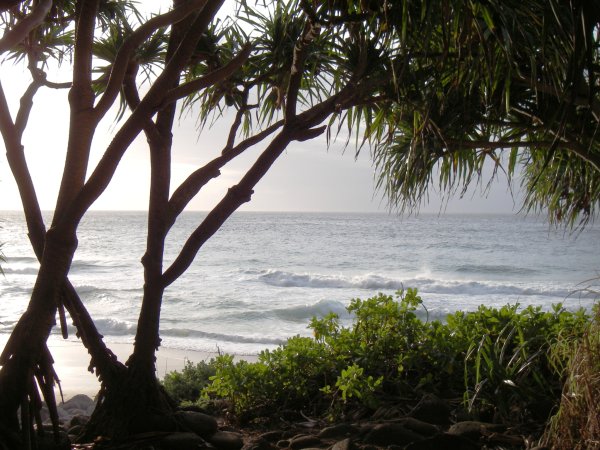
Hala tree at Hanakapiai
Day 1
I was up by 5 am the next morning before first light, due to jet-lag from a European trip—my schedule was working perfectly. I hit the trail by 5:30am and hiked several miles before the sun rose above the Pali. The trail climbs over 800 feet in 1.25 miles from the lowest point at Hanakapiai Beach to the highest point at the “Gate,” a distinctive rock overhanging the ocean below and welcoming you into the mystic valleys of the Na Pali coast. First is Ho’olulu, my favorite for the gentle downhill gradient through a hala forest and multiple sub-valleys, all wild and unexplored.
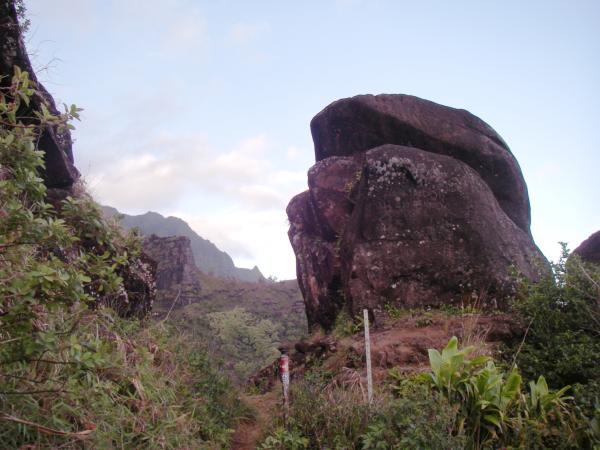
The Gate or Space Rock
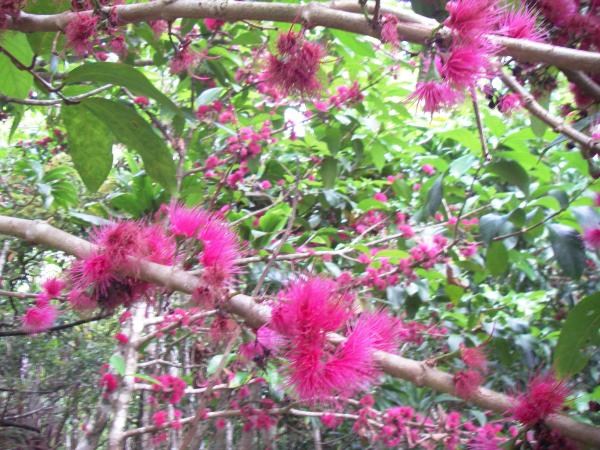
Mountain apple (syzygium malaccense) in bloom–poor photo quality due to low light
The next small valley is Waiahuakua, which has wild mountain apple trees that bloom in puffs of pink and lay a pink carpet on the trail. Sadly, I have never seen their fruit here so I don’t know if I missed the fruiting or if there’s a lack of polinators. With the dry weather, Waiahuakua has no drinkable water, but I didn’t need much in the cool morning, and the four miles to Hanakoa went quickly.
Looking at the times on my GPS track, I covered 4 miles (6 km) in 3 hours, including stops and side trails. It seemed like the miles went quickly, but that’s not very fast, so I must’ve been still asleep and just don’t remember the time going by.
In Hanakoa, I took some time to explore the two terminal ridges that I mentioned in another post. I went as far as safely possible on these narrow ridges, getting nice views into the valley and down to the ocean from both. The first photo is from the north ridge, and you can see the taller Hanakoa falls to the left in the shade (not the short falls in the sun). The second photo is from the south ridge, looking up at two distinctive peaks where only goats dare to go.
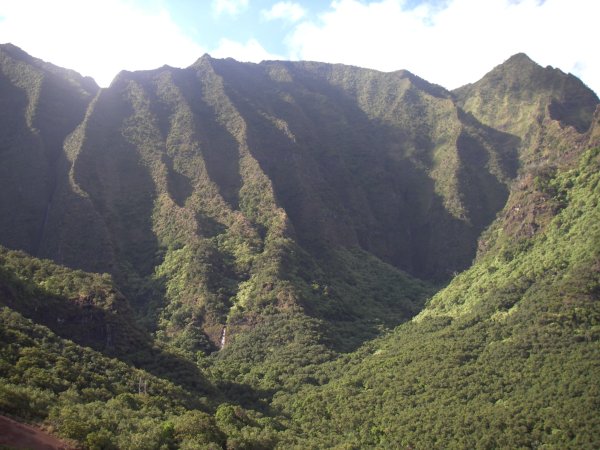
Looking into Hanakoa valley from the north ridge
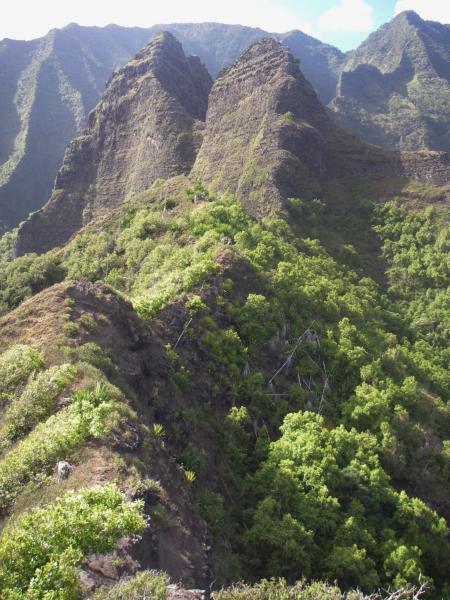
Looking up the south ridge of Hanakoa valley
I spent another hour in Hanakoa resting, filtering water and taking pictures of the exposed sections of the trail that come next (I’ll post them in a separate article). Back on the trail again, I caught up with and passed some other hikers going into Kalalau who had slept in Hanakoa. They had big packs and looked like what I call “REI campers,” identifiable by the bright orange shovel (burying human waste is discouraged and composting toilets are provided). I think certain mainland styles are less adapted to the climate and terrain of the tropics–then again, they were probably carrying food for a week and I would be hiking back out tomorrow.
An important note: camping restrictions have since changed, and permits are now given for Hanakoa instead of Hanakapiai. See the update to my previous post on the subject.
The balcony trail just after Hanakoa is the lowest point on the trail between Hanakapiai and Kalalau, at about 100 feet (30 m) above the ocean. The trail then dips in and out of several small valleys and then climbs steadily to the second highest point of the trail at the top of “Red Hill,” the entrance to Kalalau valley at around 600 feet (200 m). On this part of the trail, everyone is dreaming of being at the beach already, but the little valleys with their babling brooks and the higher vertical valleys with their groves of kukui nut trees are pretty in their own right—remember to take note of them on the hike out.
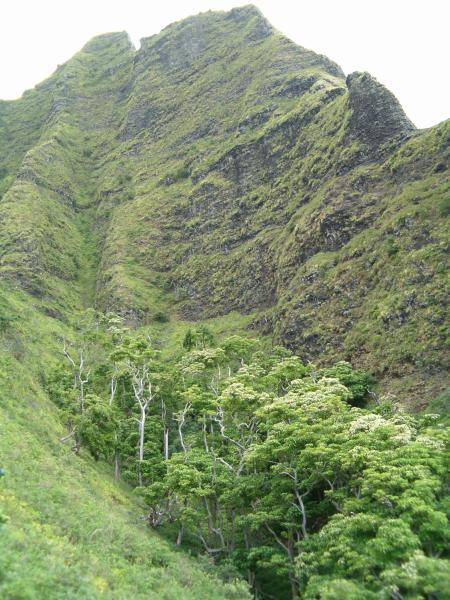
Looking up at the back side of Puu Ki before reaching the top of Red Hill
I was motivated to get to the beach before it got too hot and covered the 4 miles to the Kalalau stream in 2:15 (1.75 mph or 2.8 km/h), stopping only once to filter water for my bottles. But I was starving by then and took the time to eat lunch in the cool shade by the stream, leaning back against the 10 mile-marker. I reached the beach and the end of the trail a half mile further, for an overall time of 7 hours (6am-1pm) to cover the 8.5 miles (13.5 km) plus side trails.
I was happy to have the whole afternoon in Kalalau, so I started with a dip in the ocean to cool off and relaxed a bit at the beach. But I wanted to go exploring up in the valley and ultimately find a campsite to sleep up there. First, I followed some of the side trails up into the valley and into one of the side gullies. When that trail grew too faint, I was at the foot of a small ridge and I scrambled up to get a view. It was steeper than it looked, and the thick grasses made it hard to pass, but I eventually reached the crest.
I’m being intentionally vague about access to this ridge, not because it is any sort of secret place, but because I can’t encourage anyone to go off-trail. I do not want to be responsible for getting anyone into a dangerous situation–please be careful and realize you are hiking at your own risk. If you do go exploring, please tread lightly, avoid destroying vegetation on slopes, avoid causing erosion and rock-falls, and never, ever free-climb on the crumbly rock.
I followed the ridge upward until it became very narrow. It seemed like there was a trail on this ridge, but the number of goat droppings tells me it was just a game trail. I climbed about 1000 feet (300 m) altogether, and it seemed like I must be deep in the heart of the valley. In truth, I was only on the 3rd ridge from Red Hill and the view into the valley wasn’t much different. Looking up, however, was a fairly impressive perspective on a point that I believe is called Puu Ki. I had to stop at the foot of the tower seen in the foreground of the photo on the left.
 |
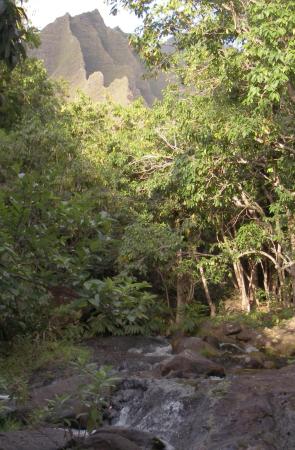 |
Backtracking down the ridge, I found some other trails that led down to the Kalalau stream, at a point where I caught a glimpse of the ridge I had just climbed (photo on the right above). From there, you can follow stream up past some very pretty cascades and pools, keeping to the south bank and weaving in and out of a bamboo grove on that side. I followed the stream for about a quarter-mile (0.5 km) before turning around. I did see a campsite, but it was already claimed by someone more or less permanantly. I also saw some of the resident “hippies” (I don’t mean that negatively, it’s just the best term I’ve heard for the free-spirited and optionally-clothed people you meet in the valley), they were sitting by a pool talking and playing a flute. I took a dip in a delightfully refreshing swimming hole, quite possibly the one I’ve heard called “Ginger Pool:”

Me cooling off in Ginger Pool
Climbing the steep bank above the stream, I found the ideal site to hang my hammock. Technically, camping in the valley is illegal, but being alone and practicing zero-impact camping, I felt I wasn’t violating the intent of the law. Again, I would be a hypocrite to condemn illegal camping, but if you follow my example, please leave absolutely no trace either: no campfire, no buried waste, and preferrably no tent on the vegetation–anyways it’s easier to hang a hammock between trees than to find a flat campsite. I have to say that falling asleep to the sound of the stream and the view of the stars over Kalalau was idyllic.
However, I had not counted on how cold it could be in the valley at night. I had a single fleece sleeping sack, which is usually sufficient on Kauai. I had forgotten that a hammock doesn’t block the wind like a tent, and the steady breeze down the valley kept me chilled. It’s possible that the cold air slides down from the Kokee forest, which lies above the valley rim at 4000′ (1200 m). Even though I estimate the temperature was in the low 60’s (15-17 C), I didn’t have any insulation in the hammock against the breeze. I put on my second shirt and huddled in my bag and managed to sleep, but I was still cold. Moral of the story: fleece sleeping sacks only work inside tents or out of the wind. Even on the beach, it’s best to have some sort of wind shell or bivy bag–though often a plastic tarp will do.
Day 2
Because of the cold, I didn’t sleep well and stayed huddled in my hammock far past the sunrise. When I did peek out finally, the view made up for any discomfort:
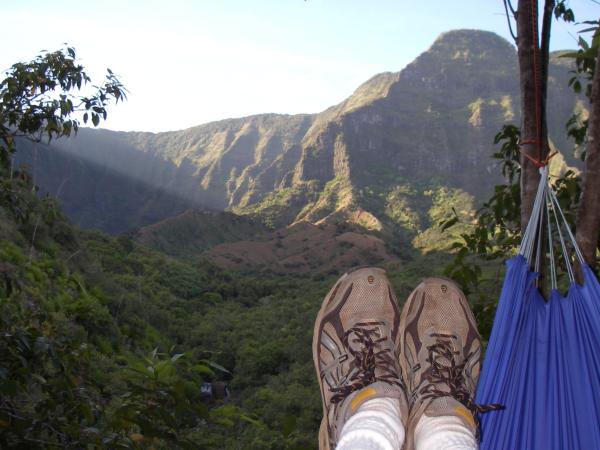
Can it get any better than this?
As you can see, I kept my shoes on at night in the hammock in case I fell out or needed to get out. I still need some practice to use the hammock gracefully. As the sun came up a bit more, it lit up the south wall of the valley, an area I sometimes call the “Cathedral” for its soaring pillars of rock that seem to curve in ribbons and mimic graceful arches:
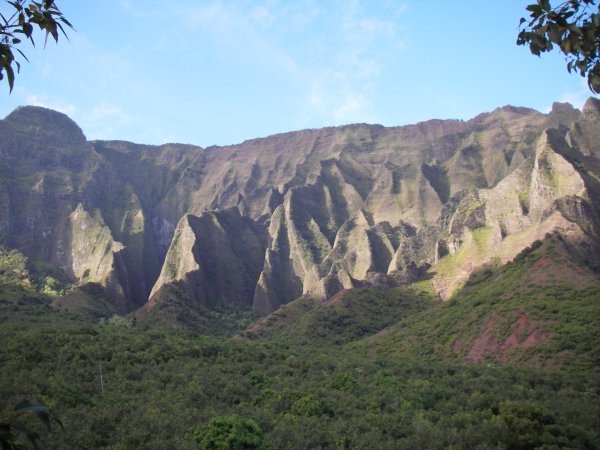
The south wall of the lower valley lit by the early morning sun
By the time I got up, had breakfast, took down my hammock, repacked my bag, and hiked back to the main trail, it was already 8:30am. If you’re easily tired by the heat like I am, this is really much too late to start the long hike back. The sun was already beating down on Red Hill, making the steep climb even hotter—and it was only 9 am. However, the views were spectacular, with the morning sun lighting up the Na Pali coast. Here’s my new desktop image:

View back towards Kalalau from Red Hill
Fortunately, the trail after Red Hill is mostly in the shade as you traverse some near-vertical walls and valleys (remember to look at the groves of oddly branching kukui trees). I had used up most of my water on Red Hill, so I was also thankful for the many streams that were not dry—they must be fed by springs in these short valleys (but I always filter and purify the water anyway). I was really feeling the effects of my jet-lag, and after the previous day’s hiking and exploring, every uphill was a struggle.
It took me two hours to hike the remaining 3 miles back to Hanakoa Valley, where I was happy that it was raining. It was too early for lunch, but I did stop to pick coffee in Hanakoa (more on that in another post). I usually like to stop for lunch at a view point overlooking the ocean, but I could find none in the shade after Hanakoa. I eventually found some shade under an overhanging cliff just around the corner into Ho’olulu Valley, but my leftover food wasn’t very appetizing. Then I made it back up to the Gate and the long downhill into Hanakapiai, averaging only about 1 mph (1.5 km/h) overall.
I always find the return to Hanakapiai to be really jarring, even after just 2 days. There are lots of people milling around, mostly day-hikers whose perspective of the trail is completely the opposite of mine at that point. Many think that they have hiked the Na Pali coast, all 2 miles of it, and no matter how out of shape they are, after 5 minutes of rest they look and feel better than those of us hiking back from Kalalau. If I had the energy, I would want to share with them how grandiose and beautiful that experience was, but from the way they seem annoyed at our slowness, our large packs, and likely our smell, I doubt these tourists would understand.
On that particular day, I was especially tired and dreading the last big hill. I sat down on a rock near the stream, and a woman practically scowled at me because I was in her picture. Mostly, I felt like I had absolutely no energy left. Even after resting and drinking, I didn’t feel like hiking anymore. Fortunately, I found a small bag of salted almonds at the bottom of my pack. I must’ve been low on sugar or maybe electrolytes (probably both), because those almonds practically revived me, or at least gave me a kick to get going up and over the hill. I finished around 4 pm, so about 7.5 hours to hike the full 10.5 miles (17 km) going out.
Unless it is pouring down rain, do not miss the swim at Ke’e Beach after hiking back. How good it feels just to float in the cool water after the long hike. Compared to Hanakapiai, the return to the crowds and traffic at Ke’e is more anonymous—everyone is enjoying the beach no matter how far they hiked or what they saw. After the swim, I rinsed off at the showers, and changed into my spare set of clothes from the car (I once forgot to leave a set of clean clothes in the car and regretted it).
Driving again felt strange, I always drive extra slow after a backpacking trip–it just feels unnatural to go fast. Fortunately, nobody can drive fast with the curves and one-lane bridges on historic route 560, and Hanalei is not far with plenty of good restaurants. Being alone this time, I just stopped in Papaya’s Natural Foods and bought some carry-out deli items which I ate outside, looking up at the mountains.
In Conclusion
While I don’t usually hike alone, I was glad I had the opportunity this trip. Besides the freedom to go exploring, I also had the time and mental space to reflect on the experience. What I found myself thinking over and over was how lucky I was to be in such an awesome and unique place. At other times, I have also enjoyed meeting other campers, both visitors and residents, and learning about their perspectives on the valley.
The isolation reduces the world to the space between the cliffs and the ocean, and so your focus is concentrated on the trail. After the satisfaction of reaching Kalalau, you are rewarded with a miniature garden of Eden affording either exploration or total relaxation in a grandiose setting. Except for the helicopters, the world beyond might not exist at all, and I for one never miss it. Unlike other trails that I do for the views or the sense of accomplishment, Kalalau is a hike and destination that I would do over and over for that feeling of living close to nature in a simpler, more beautiful world.
I hiked the Kalalau trail about 13 years ago in October. It was not only my first backpacking trip, but it was my first solo backpacking trip. It was awesome.
There is one danger that I didn’t find mentioned in your post or in one of your referenced sources. It involves the kukui nut tree. While at Kalalau beach, I was enjoying some vegetarian chili with the “hippies” and listening to one of them talk about the dangers of kukui nut trees. He said that they tend to drop their branches after heavy rains, and he related a very engrossing story about some Japanese tourists who were nearly clobbered by a kukui nut tree branch.
When it was time to go to bed, I walked back to my campsite and found a massive tree branch had fallen right across my tent. It had come down with such force that the metal tent spikes were thrown clear of the camp site and bent beyond usefulness. If I had been in that tent when the branch had fallen, I would probably be dead now. God must have been watching over me during that trip.
So, the obvious moral of the story is: DON’T CAMP UNDER A KUKUI NUT TREE.
Mahalo for sharing your experience and the lovely photos. You’ve almost inspired this old broad to take up wilderness exploration.
Visiting for the Carnival of Aloha. I’m curious about something. I’ve never visited a blog that allows comments but doesn’t allow visitors to post their url. Is that a spam-control measure on your behalf? Not saying it’s either good or bad, just curious.
Happy to have found this wonderful post through your article submission to Evelyn’s Aloha Blog Carnival. I hope lots of Kauai visitors will read it too. Our Big Island hikes into Pololu and Waipio Valley seem to be beginners’ hiking level compared to this one. One has to have the knowledge, right hiking equipment and definitely the commitment and dedication ti make this hike a success. The reward is worthwhile the efforts. Aloha, Pua
This is such a great testament to the beauty that is Kaua’i! It’s funny that you should mention how the trail was not muddy because it has been so dry, etc., and then show us all these lush, green photos! What does that say? It brings back memories of Makaha Valley on Oahu so many years ago. I wish I had thought to take pictures back then! Sigh.
Wonderful trip report with just the right amount of detail. The photos are excellent. Thank you for sharing. Maybe some day I’ll hike to Kalalau for real, until then your trip reports are the next best thing.